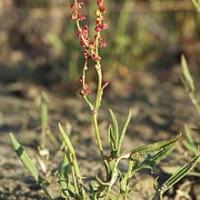Sheep’s sorrel
Rumex acetosella
A perennial herb that has a slender and reddish upright stem that is branched at the top, reaching a height of 18 inches (0.5 meters). The arrow-shaped leaves are small, slightly longer than 1 inch (3 cm), and smooth with a pair of horizontal lobes at the base. It blooms during March to November, when yellowish-green (male) or reddish (female) flowers develop on separate plants at the apex of the stem, which develop into the red fruits (achenes).
Rumex acetosella is widely considered to be a hard-to-control noxious weed due to its spreading rhizome. Blueberry farmers are familiar with the weed because it thrives in the same conditions under which blueberries are cultivated.
Distribution and habitat
The plant is native to Eurasia and the British Isles, but it has been introduced to most of the rest of the northern hemisphere. It is commonly found on acid, sandy soils in heaths and grassland. It is often one of the first species to take hold in disturbed areas, such as abandoned mining sites, especially if the soil is acidic. Livestock will graze on the plant, but it is not very nutritious and is toxic in large amounts because of oxalates. The American Copper or Small Copper butterfly depends on it for food.








